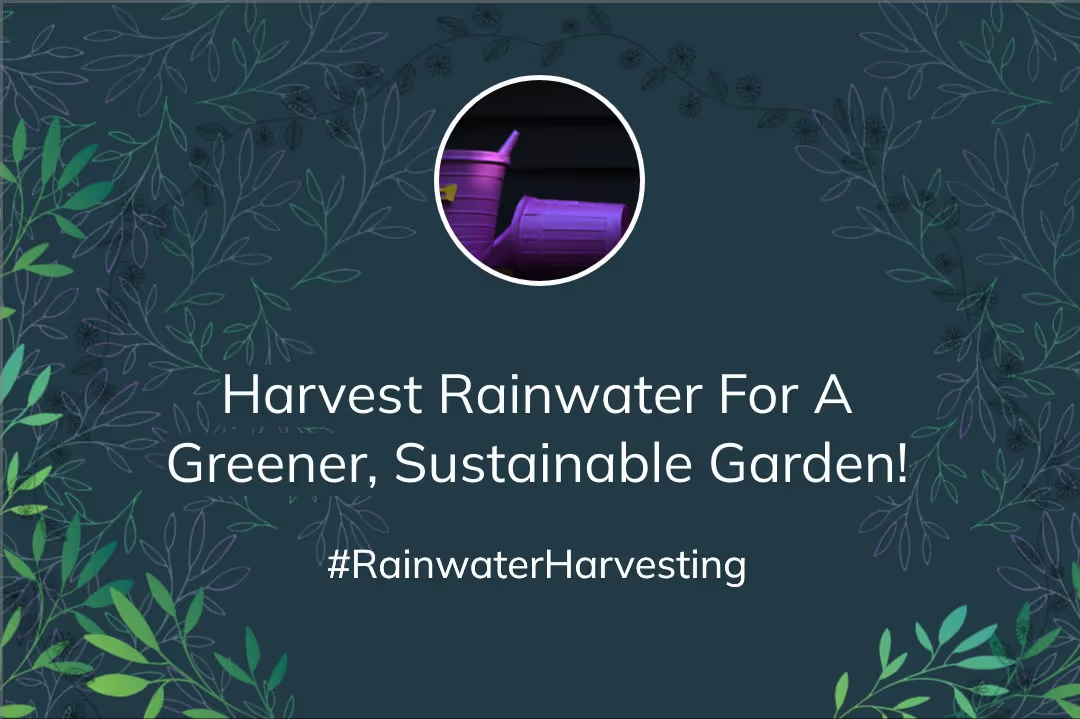Harvest Rainwater For A Greener, Sustainable Garden

Rainwater Harvesting
Put those rainy afternoons to good use—one inch of rainfall on a 1,000-square-foot roof yields over 600 gallons ready for rainwater harvesting. Position a rain barrel beneath your downspout, and you've laid the groundwork for a smarter garden. Practicing rainwater harvesting cuts your water bill, eases stress on the municipal water supply, and boosts plant health. Stick around, there's beauty in gardening smarter.
🌧️ Rainwater Harvesting Cheatsheet: Sustainable Gardening Essentials
💧 Install Efficient Collection Systems
- 🏠 Rain Barrels: Place under downspouts; screens prevent debris.
- 📦 Cisterns: Underground tanks help store large volumes.
- 🍃 Rain Chains: Guide water beautifully and quietly from roofs.
🌱 Maximize Garden Sustainability
- 🌾 Plant Drought-Resistant Varieties: Herbs, succulents, native perennials.
- 🌻 Mulch Heavily: Organic mulch conserves harvested water, reduces evaporation.
- 🥕 Grow Edibles: Boost nutrition and food security by irrigating sustainably.
🛠️ Practical Maintenance Tips
- 🔍 Inspect Regularly: Check for leaks, clogs, algae monthly.
- 🧹 Annual Clean-Up: Drain, scrub barrels and cisterns every year.
- ❄️ Cold-Climate Precautions: Drain systems before freeze (32°F / 0°C).
📊 Quick Fact
💡 Every 1 inch (2.5 cm) rainfall over 1,000 sq. ft. (~93 m²) roof yields ~600 gallons (2,270 liters) usable water.
Why Rainwater Harvesting Matters for Gardeners
I remember the summer drought three years ago that blistered my patio tomatoes and left my hydrangeas gasping—painful stuff. A wake-up call that relying solely on municipal water wasn't sustainable for my garden or my conscience.
That's when I started experimenting with rainwater harvesting, capturing nature's free bounty to nurture my plants.
The Simple Beauty of Capturing Rainwater
Rainwater harvesting sounds technical, but it's as straightforward as setting out a container to catch falling rain. Over time, I upgraded from buckets, graduated to barrels, and eventually installed a dedicated cistern system.
The results? Extraordinarily satisfying.
Did you know a 100-square-foot (9.3-square-meter) roof can collect over 60 gallons (227 liters) of rainwater from just one inch (2.5 cm) of rain?
I find myself standing out on cloudy days, eyes skyward, grinning like a fool—knowing every drop is precious treasure gardening-wise.
Benefits I've Experienced with Rainwater Harvesting
- Water bill reduction: My monthly usage plummeted dramatically.
- Healthier plants: Rain is naturally soft and free of chlorine or fluorides—my plants flourish like never before.
- Reduced stormwater runoff: My garden contributes less polluted runoff toward local waterways, a big ecological plus.
Moreover, harvested rainwater naturally replenishes groundwater reserves, aiding entire ecosystems near and far.
Steps to Set Up Your Own Rainwater Harvesting System
If you're intrigued, let me share the straightforward method I implemented:
- Select the right container: Start modestly with sturdy barrels—food-grade plastic is easiest. I began with two 50-gallon (189-liter) barrels.
- Choose location wisely: Position barrels under gutter downspouts to max out rainfall capture. Remember gravity helps—higher position equals better flow.
- Add a filter screen: Keeps out debris, mosquitoes, and unwanted elements. Trust me, cleaned fewer gutters since.
- Implement an overflow solution: Essential for heavy rains. Guide overflow toward thirsty flower beds or install a secondary barrel.
- Tap and use easily: Outfit your setup with an accessible spigot. Connecting a hose or filling watering cans should feel effortless.
Watching rainwater slide smoothly into my barrels during a storm brings genuine joy—like banking liquid gold for sunnier days.
A Few Quick Rainwater Harvesting Tips from Experience
- Cover barrels: Keeps algae growth under control and restricts mosquito breeding.
- Check local regulations: Some areas restrict rainwater collection; verify first, stay on the right side of bureaucracy.
- Use harvested water promptly: Stagnant water breeds trouble. Keeping it circulating through regular garden watering simplifies your life.
And trust me—you'll love this approach. Rainwater harvesting transformed my perspective in gardening, deepening my connection and gratitude toward nature's rhythms.
"If we work with natural cycles, we ride the wave of abundance—that includes cherishing every drop nature sends down from the darkened clouds." —Anonymous Garden Sage
Frequently Asked Questions about Rainwater Harvesting for Gardens
How much rainwater can I collect from my roof?
The volume of rainwater you can collect depends on your roof's surface area and rainfall patterns. For every inch (25 mm) of rainfall on a 1000-square-foot (approximately 93 m²) roof, you may collect up to 600 gallons (around 2,270 liters) of water. Measure your roof's area and local rainfall averages to estimate potential water collection.
Do I need special equipment to start rainwater harvesting?
You need simple components such as a rain barrel or storage tank, a gutter and downspout system to direct rainwater, and a filtration screen to keep debris out. Optional additions like filters or pumps make distribution easier, depending on your garden’s needs.
How should I store collected rainwater safely?
Store rainwater in properly enclosed containers to eliminate sunlight exposure and prevent algae growth. Regularly clean your collection tanks and barrels, and use fine-mesh screens over openings to stop insects, leaves, and contaminants.
Can rainwater harvesting benefit my plants significantly?
Yes, rainwater provides significant benefits to plants. It contains fewer salts and chemicals than tap water, reducing soil buildup and promoting healthier plant growth. Using harvested rainwater also reduces dependence on municipal water, conserving essential resources.
What guidelines should I follow when watering my vegetable garden with harvested rain?
Use harvested rainwater primarily at the base of vegetable plants to lower disease risk from foliage moisture. To maintain plant health, water plants early in the morning or late afternoon when evaporation rates decrease.
Does rainwater need treatment before watering edible plants?
Normally, rainwater requires no special treatment before applying it to edible plants, especially when collected from clean roof surfaces and stored in covered, well-maintained containers. However, avoid rainwater harvested from roofs constructed of materials that release harmful chemicals, such as lead-based paints or treated wood shingles.
How can I maintain my rainwater harvesting system effectively?
Inspect storage barrels or tanks regularly for leaks or damage. Clean gutters and filters frequently to prevent clogging and debris buildup, especially during high rainfall periods. Empty and rinse storage containers out annually to ensure optimal performance and water quality.
Rainwater harvesting offers a simple elegance: capturing nature's gift to nurture your garden. This practice reduces water bills, eases strain on municipal supplies, and promotes healthier plants free from chemical additives. By integrating barrels, cisterns, or rain gardens, gardeners create resilient, sustainable spaces deeply aligned with natural cycles. Wise gardeners know the value of working alongside nature; rainwater harvesting is gardening at its most resourceful—rooted, responsible, and respectful of our earth's rhythms. Start collecting today, and watch your garden flourish sustainably, beautifully, and abundantly.
Find out which plants will thrive in your garden!
Answer a few fun questions and get custom plant recommendations perfect for your space. Let’s grow something amazing together!

start your season




